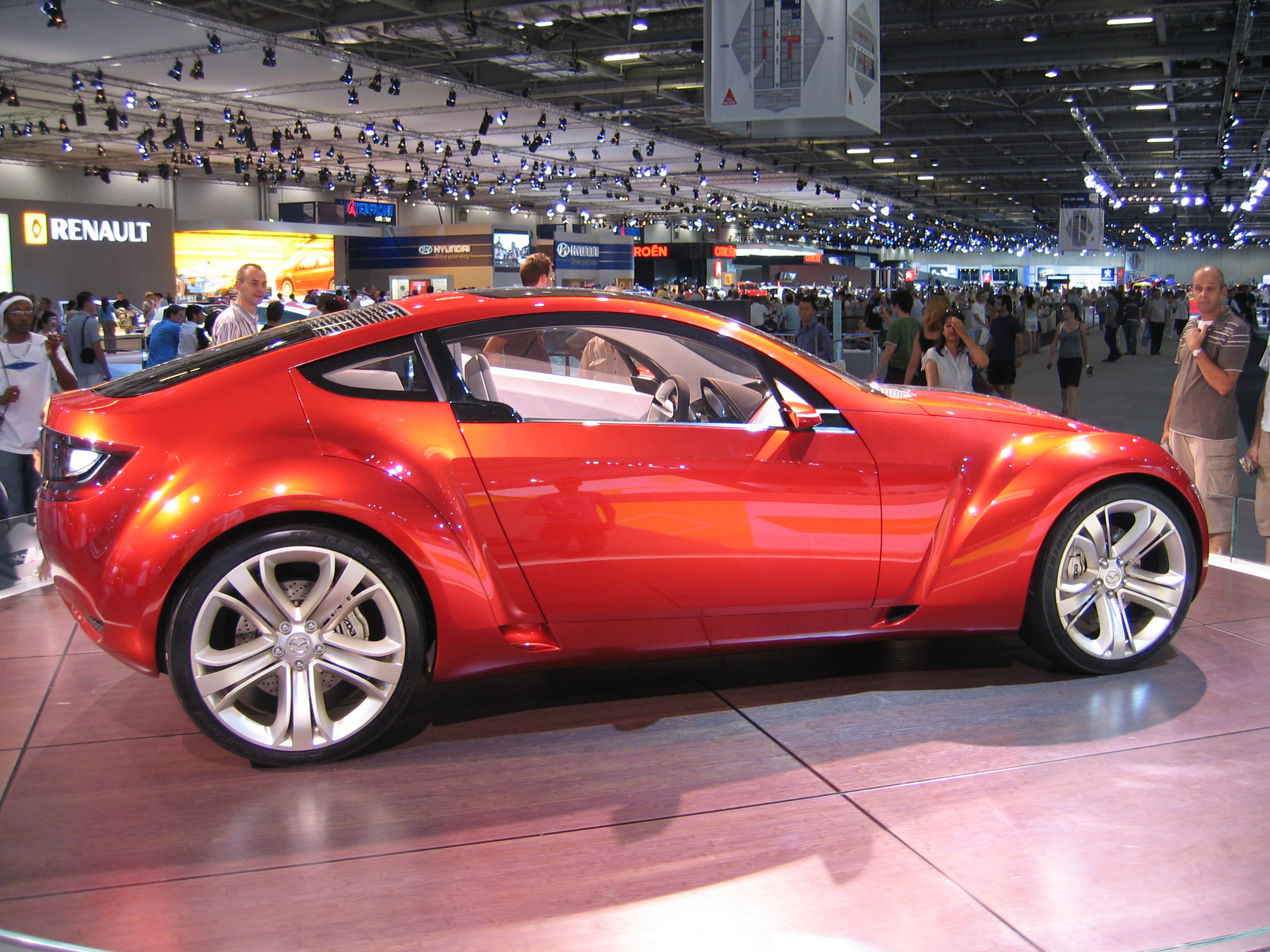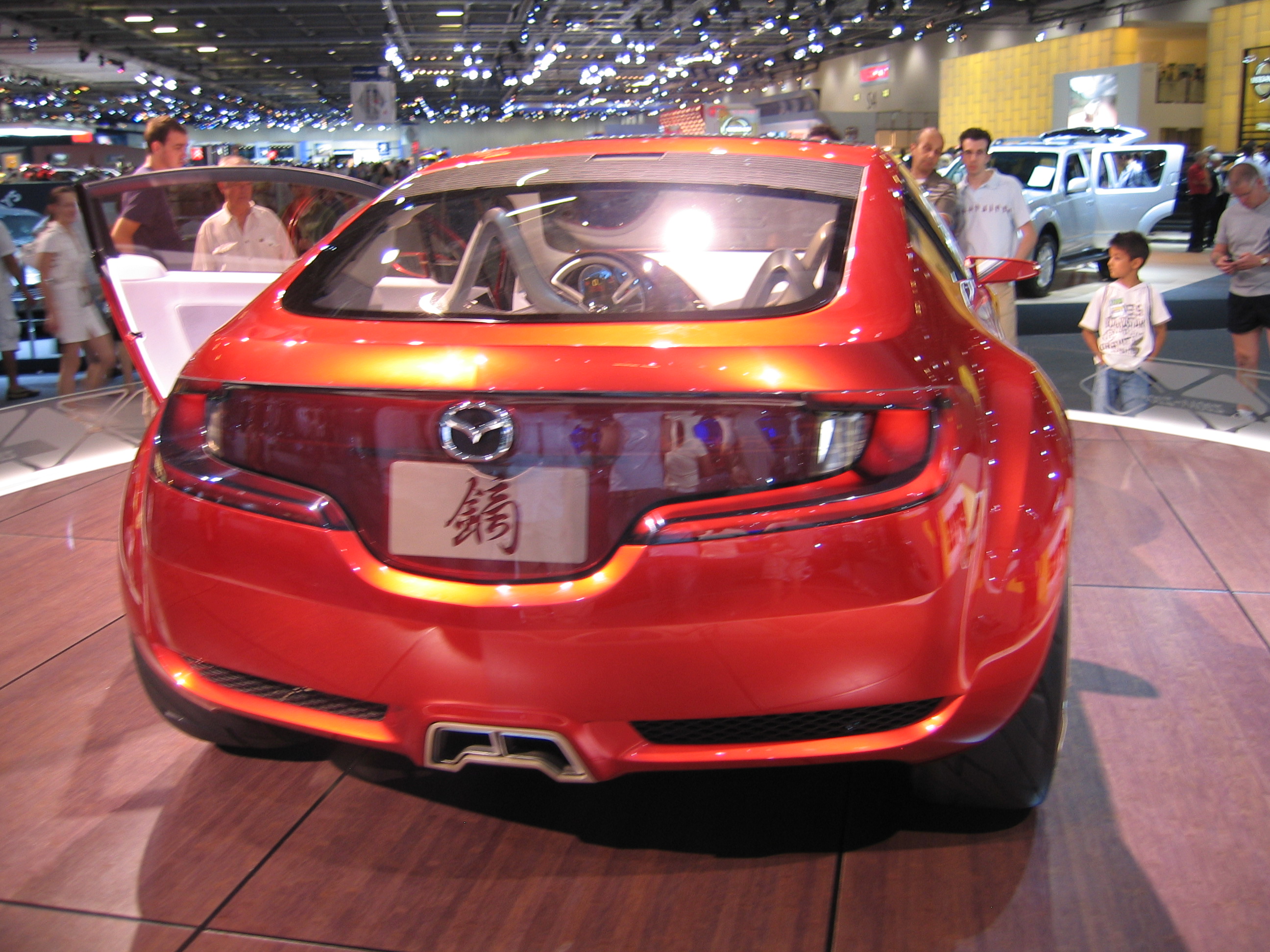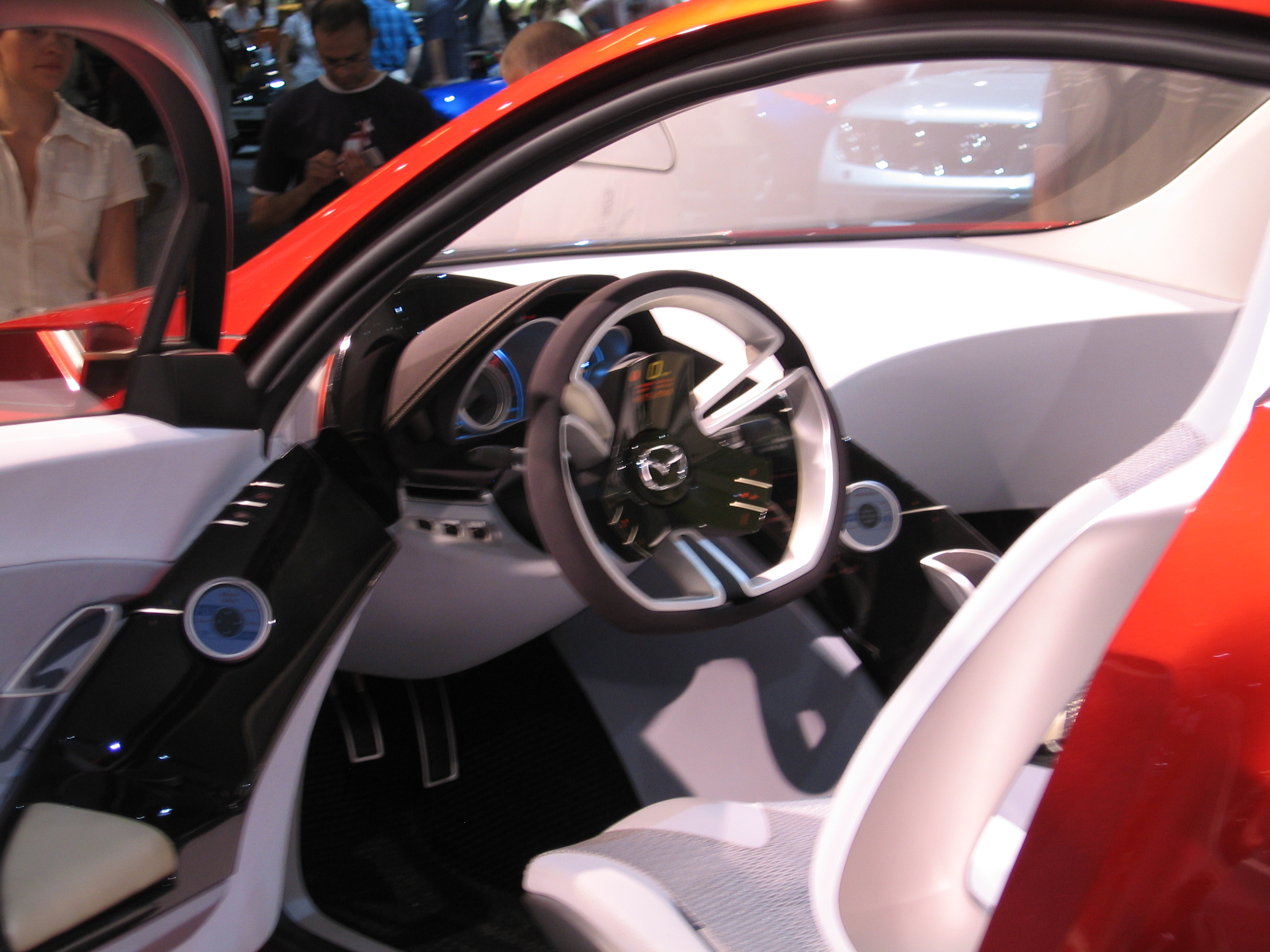Mazda Kabura on:
[Wikipedia]
[Google]
[Amazon]
The Mazda Kabura is a

 Power is supplied to Kabura concept's rear wheels from a 2.0 L version of Mazda's MZR
Power is supplied to Kabura concept's rear wheels from a 2.0 L version of Mazda's MZR
 The driver's door provides access to the driver's cockpit, and to the rear jump seat. The other side of the car is a purposely asymmetrical arrangement. Eliminating the glovebox and minimizing the instrument panel allows shifting the front passenger about six-inches ahead of the driver's seating position. In turn, the second inside passenger, sitting in tandem behind the inside passenger, has approximately the same leg, shoulder, and headroom as the front passenger. The Kabura includes a secondary passenger-side door, allowing easier access to the seat behind the front passenger. After the front door is opened, touching a button slides the rear door straight back into a cavity notched into the rear-quarter panel area, instead of swinging on hinges.
Kabura's concept interior is produced from regenerated leather substrate, mostly from post-industrial waste recovered from the manufacturing of
The driver's door provides access to the driver's cockpit, and to the rear jump seat. The other side of the car is a purposely asymmetrical arrangement. Eliminating the glovebox and minimizing the instrument panel allows shifting the front passenger about six-inches ahead of the driver's seating position. In turn, the second inside passenger, sitting in tandem behind the inside passenger, has approximately the same leg, shoulder, and headroom as the front passenger. The Kabura includes a secondary passenger-side door, allowing easier access to the seat behind the front passenger. After the front door is opened, touching a button slides the rear door straight back into a cavity notched into the rear-quarter panel area, instead of swinging on hinges.
Kabura's concept interior is produced from regenerated leather substrate, mostly from post-industrial waste recovered from the manufacturing of
Initial Ford/Mazda Media PR releaseFinal Ford/Mazda Media Press Release''Road & Track'' magazine reportOfficial Mazda USA Kabura web site
{{Mazda vehicles Kabura Sports cars Rear-wheel-drive vehicles Cars introduced in 2006
concept car
A concept car (also known as a concept vehicle, show vehicle or prototype) is a car made to showcase new styling and/or new technology. They are often exhibited at motor shows to gauge customer reaction to new and radical designs which may or ...
shown by the Japan
Japan ( ja, 日本, or , and formally , ''Nihonkoku'') is an island country in East Asia. It is situated in the northwest Pacific Ocean, and is bordered on the west by the Sea of Japan, while extending from the Sea of Okhotsk in the north ...
ese manufacturer
Manufacturing is the creation or production of goods with the help of equipment, labor, machines, tools, and chemical or biological processing or formulation. It is the essence of secondary sector of the economy. The term may refer to a ran ...
Mazda
, commonly referred to as simply Mazda, is a Japanese multinational automotive manufacturer headquartered in Fuchū, Hiroshima, Japan.
In 2015, Mazda produced 1.5 million vehicles for global sales, the majority of which (nearly one m ...
in 2006.
Concept overview
The Kabura, introduced at the 2006 North American International Auto Show, is asport compact
Sport compact is an American car classification for a high-performance version of an affordable compact car or a subcompact car. There is no precise definition and the description is applied for marketing purposes to a wide variety of models.
C ...
which shows styling themes and technologies which could appear in future production models. It was designed in Irvine, California
Irvine () is a Planned community, master-planned city in South Orange County, California, United States, in the Los Angeles metropolitan area. The Irvine Company started developing the area in the 1960s and the city was formally incorporated on ...
by Mazda of North America design chief Franz von Holzhausen
Franz von Holzhausen (born May 10, 1968) is an American vehicle designer. Since 2008, he has been in charge of design at Tesla Inc., Tesla, Inc. He designed the Tesla Model S, Tesla Model 3, Model 3, Tesla Model X, Model X, Tesla Model Y, Model Y, ...
, who designed the Pontiac Solstice
The Pontiac Solstice is a sports car that was produced by Pontiac. Introduced at the 2004 North American International Auto Show, the Solstice roadster began production in Wilmington, Delaware, starting in mid-2005 for the 2006 model year. It ...
.
Kabura incorporates the front-engine, rear-drive layout similar to the Mazda MX-5
The Mazda MX-5 is a lightweight two-passenger roadster sports car manufactured and marketed by Mazda with a front mid-engine, rear-wheel-drive layout. The convertible is marketed as the or in Japan, and as the Mazda Miata () in the United Sta ...
and the Mazda RX-8
The Mazda RX-8 is a sports car manufactured by Japanese automobile manufacturer Mazda between 2002 and 2012. It was first shown in 2001 at the North American International Auto Show. It is the successor to the RX-7 and, like its predecessors in ...
and hints of physical design characteristics similar to the Mazda RX-8
The Mazda RX-8 is a sports car manufactured by Japanese automobile manufacturer Mazda between 2002 and 2012. It was first shown in 2001 at the North American International Auto Show. It is the successor to the RX-7 and, like its predecessors in ...
and the discontinued Mazda MX-3
The Mazda MX-3 is a four-seat coupé front wheel drive manufactured and marketed by Mazda, introduced at the Geneva Auto Show#1991, Geneva Auto Show in March 1991 and marketed for model years 1992–1998.
The MX-3 was also marketed as the Mazda ...
. Instead of a typical 2+2 layout, the Kabura has an unusual 3+1 arrangement, giving greater passenger space versus a traditional coupe, without increasing weight or size. All passenger seats fold flat to make additional room for cargo.
“Kabura” is a Japanese term taken from ''kabura-ya
is a type of Japanese arrow used by the samurai class of feudal Japan. Kabura-ya were arrows which whistled when shot and were used in ritual archery exchanges before formal medieval battles.
Like a Wind instrument, the sound was created by ...
'', an arrow that makes a howling sound when fired, and was historically used to signal the start of a battle. This “first arrow into battle” is meant to represent Mazda's pursuit of unique styling themes and technologies - such as the rotary engine. Kabura represents the first Mazda compact coupe for the 21st century. Mazda has not announced plans to build a production version of the Kabura, but the design embodies several innovations that Mazda could implement when a compact sports coupe is ready for production. One of Kabura's roles is exposing a possible future design direction for a new model.

 Power is supplied to Kabura concept's rear wheels from a 2.0 L version of Mazda's MZR
Power is supplied to Kabura concept's rear wheels from a 2.0 L version of Mazda's MZR DOHC
An overhead camshaft (OHC) engine is a piston engine where the camshaft is located in the cylinder head above the combustion chamber. This contrasts with earlier overhead valve engines (OHV), where the camshaft is located below the combustion c ...
16-valve engine. The Kabura uses 245/35R19 Bridgestone
is a Japanese multinational tire manufacturer founded in 1931 by Shojiro Ishibashi (1889–1976) in the city of Kurume, Fukuoka, Japan. The name Bridgestone comes from a calque translation and transposition of , meaning 'stone bridge' in Japan ...
Potenza front tires and 245/35R20 tires at the rear. While this concept has been assembled with several MX-5 chassis components, the basic dimensions fall between the MX-3 and the RX-8. As a sport compact
Sport compact is an American car classification for a high-performance version of an affordable compact car or a subcompact car. There is no precise definition and the description is applied for marketing purposes to a wide variety of models.
C ...
, it would have slotted below the RX-8 in the Mazda lineup.
Exterior
The Kabura's exterior is described as a wide "powerful" stance, with pronounced wheel arches and taut surfaces, reminiscent of classic coupes. The windshield and forward portion of the roof are integrated into one seamless glass surface that extends from the cowl to the B-pillar. Overhead portions of the glass have adjustable tinting, so that the driver can adjust a knob to change the roof's opacity, as desired, from clear to completely opaque. Behind the B-pillar is a two-piece glass hatch. The uppermost glass panel normally lies flush. When pivoted-up by an electric motor, it acts as a roof spoiler, which also vents air from the interior and increases rear passenger headroom. A photovoltaic solar cell in the panel helps to control interior temperature, as well as helping recharge the battery for powering accessories. The larger glass hatch panel has side-mounted hinges to provide access to the Kabura's cargo compartment.Interior
The unique 3+1 interior layout is designed to provide comfortable seating for one or two tandem passengers to the right of the driver, with only occasional use of the fourth "jump-seat" behind the driver as needed. The driver's door provides access to the driver's cockpit, and to the rear jump seat. The other side of the car is a purposely asymmetrical arrangement. Eliminating the glovebox and minimizing the instrument panel allows shifting the front passenger about six-inches ahead of the driver's seating position. In turn, the second inside passenger, sitting in tandem behind the inside passenger, has approximately the same leg, shoulder, and headroom as the front passenger. The Kabura includes a secondary passenger-side door, allowing easier access to the seat behind the front passenger. After the front door is opened, touching a button slides the rear door straight back into a cavity notched into the rear-quarter panel area, instead of swinging on hinges.
Kabura's concept interior is produced from regenerated leather substrate, mostly from post-industrial waste recovered from the manufacturing of
The driver's door provides access to the driver's cockpit, and to the rear jump seat. The other side of the car is a purposely asymmetrical arrangement. Eliminating the glovebox and minimizing the instrument panel allows shifting the front passenger about six-inches ahead of the driver's seating position. In turn, the second inside passenger, sitting in tandem behind the inside passenger, has approximately the same leg, shoulder, and headroom as the front passenger. The Kabura includes a secondary passenger-side door, allowing easier access to the seat behind the front passenger. After the front door is opened, touching a button slides the rear door straight back into a cavity notched into the rear-quarter panel area, instead of swinging on hinges.
Kabura's concept interior is produced from regenerated leather substrate, mostly from post-industrial waste recovered from the manufacturing of Nike
Nike often refers to:
* Nike (mythology), a Greek goddess who personifies victory
* Nike, Inc., a major American producer of athletic shoes, apparel, and sports equipment
Nike may also refer to:
People
* Nike (name), a surname and feminine give ...
brand athletic shoes.
Specifications
*Length: 4.05 m (159.4 in.) *Width: 1.78 m (70.1 in.) *Height: 1.28 m (50.4 in.) *Wheelbase: 2.55 m (100.4 in.) *Seating capacity
Seating capacity is the number of people who can be seated in a specific space, in terms of both the physical space available, and limitations set by law. Seating capacity can be used in the description of anything ranging from an automobile that ...
: 4 person (3+1 seating)
*Engine: MZR 2.0 L DOHC 16-Valve
*Transmission: 6MT manual
*Suspension (F/R): Double Wishbone / Multi-Link
*Tires - Front: 245/35 R19
*Tires - Rear: 245/35 R20
Production version
A production version of the Kabura was rumoured for the 2009 model year. Slotting in as an entry-level alternative to the RX-8 2+2, the Kabura was said to borrow significant mechanical components from the MX-5 roadster while having a similar shape to the MX-3. Although it never entered production, the 2011 RX-8 refresh drew inspiration from the Kabura.References
External links
Initial Ford/Mazda Media PR release
{{Mazda vehicles Kabura Sports cars Rear-wheel-drive vehicles Cars introduced in 2006